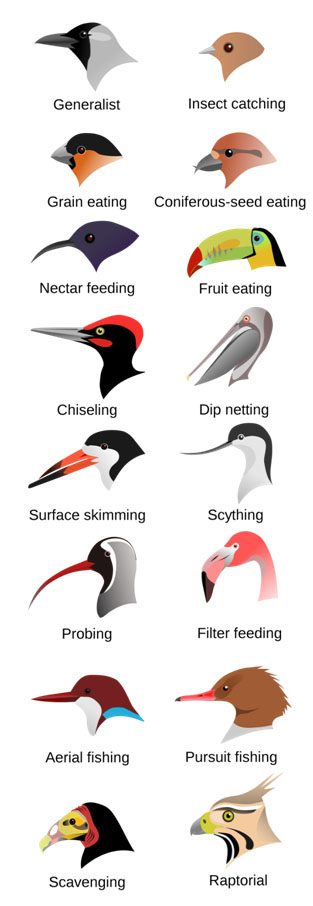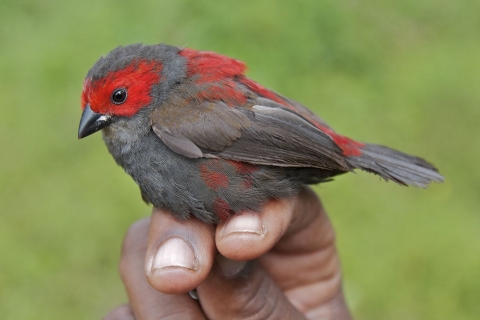Which Beak Is Best for Birds Who Eat Thick Seeds
Conical bills are short and thick and are observed in sparrows and cardinals. It picks up insects caches acorns by pushing them into the ground and hammers open seeds nuts and occasionally eggs.
In general one of the most typical and most preferred seeds available on the market nowadays is millet bird seed.

. It is best if you have a wide range. This helps it to pick up seeds and worms easily and crushes with its beak to eat. The repetitive chewing action naturally wears down their beak.
The sparrow has a short hard and pointed beak. The size of a birds beak can help indicate the kind of seed or nut the bird is adapted to eat. In many cases they have a short robust beak that ends in a conical shape allowing them to break seeds.
Friedman and colleagues discovered that while the thickness of a birds beak was related to how they foraged and what they ate climate also played a role in shaping honeyeater beaks. Shafer Seed 84075 White Proso Millet Wild Bird Food. But if we magnify the process and slow it down we can see how it works.
In the blink of an eye they extract the nutritious contents and they do it so fast it looks like a magicians sleight of hand. They learn that birds beaks come in many different sizes and shapes according to their specialized function. If youre going to use wooden toys.
Woodpeckers have a peculiar beak that is rather long. The next time a bird lands at your bird feeder grab a handy pair of binoculars and watch closely. Some that are tiny for instance grass seeds or couscous some that are medium-sized black-eyed peas or lentils and some that are larger almonds cashews.
As a matter of fact it is deemed as a universal seed that could be consumed by any breed of seed-eating rodents and birds. They come in useful when cracking open seeds. Birds beaks have a great range of specialized shapes to catch and eat different kinds of.
To attract the widest variety of birds to your feeder youll want the bird food blend that has all the right ingredients. Cracking beaks are usually thicker and stronger than other types of beaks. April 20 2009.
Some other birds like pigeons and peacocks also have similar type of beaks. Short hard pointed beak. Fish-eater The beak of this black-crowned night.
Explore how bird beaks are adapted for eating different foods with the fifth lesson in our Feathered Friends resource available as a free download. Goldfinch on a Rowan tree. Black oil sunflower seed is considered the best all-around for feeding birds.
The diet of granivorous birds consists of seeds. The correct option among all the options that are given in the question is the second option or option B. The bird uses its thick tongue to move the nut between the upper and lower mandible to crack it open.
Cardinal Bird Their beaks are interesting in that they have a conical form and are short. Red-bellied and Downy woodpeckers. Goldfinches sparrowsand canaries are all good examples.
A Blue Jay uses its long beak as an all-purpose tool. Photo by Susan SpearCornell Lab. In this lesson students explore the concept of which beaks are best for what food.
However not all birds prefer this seed due to its bitter taste examples of. Seed-eaters such as this Gouldian Finch have short cone-shaped beaks that are well-suited for pecking up seeds. Birds like finches and cardinals love sunflower seeds which they take into their stout triangular beaks one after the other.
This type refers to. Honeyeaters such as the Black-headed Honeyeater that inhabit cooler regions of Australia had shorter beaks than their relatives and a shorter beak is better for heat retention but not as. Parrots have a short lower mandible which fits into the longer hooked maxilla upper mandible.
The seed that attracts the widest variety of birds and so the mainstay for most backyard bird feeders is sunflower. This helps them break apart seeds no matter how tough or hard they are. These strong curved beaks can crack through a hard seed or nut to get at its nutricious centre.
Birds like northern cardinals rose-breasted grosbeaks evening grosbeaks and purple finches have thick short beaks designed for breaking open seeds with ease. This variety contains twenty-six percent fat eighteen percent carbs and fifteen percent protein. Birds that prefer eating safflower seeds are.
Advertisement Brainly User B. This beak helps it to crack open nuts or seeds and scoop out the pulp of fruits with the help of it. Other varieties of seed can help attract different types of birds to round out your backyard visitors.
Most birds except for parrots and birds of prey such as eagles and falcons catch and hold their food with their beak or bill alone. And other species of birds that have beaks that are strong enough to open this type of sunflower seed. Parrots love to spend their free time pecking and knocking around on toys.
When the bird closes its beak the sharp lower mandible crushes the seeds shell so the bird can eat the seed within. Crows have versatile beaks that help them consume a variety of food materials like fruits seeds insects fish and other small animals. Short thick beak is the type of beak among the following choices given in the question that would be best for a bird whose food is thick seeds.
Placing chew toys like our favorite option here in your parrots cage is a simple yet highly effective way to help prevent overgrown beaks. Military macaws have large beaks that are ideal for opening and breaking into hard shelled seeds and nuts these birds are distributed in the forests of Mexico and South America J Bernardo Sanchez Red-winged blackbirds are omnivorous birds found in most of North and Central America Gargi Biswas. I hope that the answer has come to your help.
Canaries grosbeaks finches and cardinals are types of granivorous birds. The shape and size of a birds beak can tell us what it eats and sometimes how it catches its prey.

Project Beak Adaptations Beaks Cracking

Bird Beaks Different Types Of Beaks Dk Find Out



No comments for "Which Beak Is Best for Birds Who Eat Thick Seeds"
Post a Comment